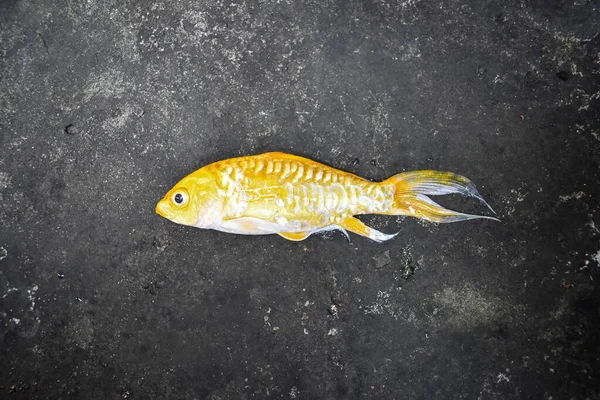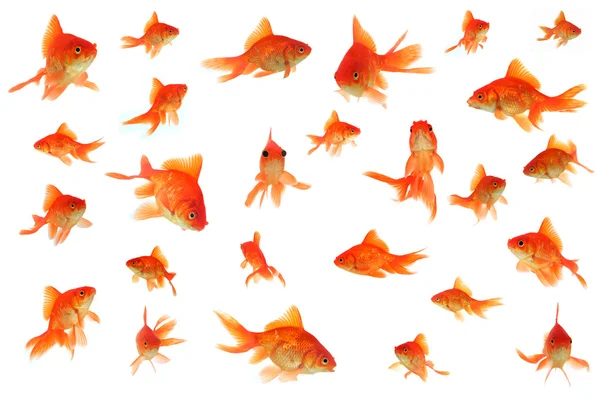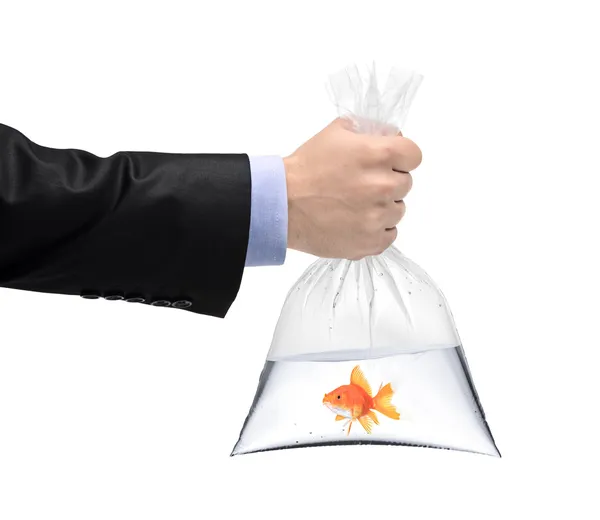Goldfish are normally very long-lived fish. In fact, owning a goldfish is more like entering a long-term relationship. They normally live for several decades when well cared for.
If your goldfish are dying quickly, it is a sign that something is wrong with either their environment or the fish itself. So, why do goldfish die so fast? Let’s talk about several reasons why you might find a dead fish one day.
Poor Water Quality for Aquarium Fish

By far, the common reason why you might wake up one day to find a dead fish is because of problems with poor water quality. Goldfish are very hardy, hardier than most pet store fish, in fact.
They can thrive across a wide range of water temperature and chemistry levels. But if the water parameters stray into toxic regions, then your fish will die very quickly.
High Levels of Ammonia

If you have been keeping fish for some time, then you’ve likely come across the term “ammonia” when reading about water quality. Ammonia is the main chemical that fish release as a waste product.
It is produced when fish metabolize protein. In nature, a body of water is usually so massive that fish waste doesn’t create any significant pollution. Ammonia and other fish waste substances are also fertilizers for aquatic plants and algae.
Separated from this web of aquatic life, ammonia can accumulate. If you have too many fish, the problem becomes even worse faster until you have goldfish dying from too much ammonia in the water. Symptoms of high ammonia include black or red patches forming in the skin, lethargy, and inflamed gills.
Excess food is another major reason why tank water becomes polluted. Rather than fish waste, the source is bacteria that start rotting the leftover food, releasing ammonia and lowering the water quality.
Regular water changes and a healthy nitrogen cycle are key to helping a goldfish thrive and live a natural, long life. Goldfish should also be kept in aquariums with filters instead of bowls. Goldfish bowls have no water circulation, change in temperature very quickly, no filtration system, and are far too small for these large, dirty fish. Hopefully, pet stores will one day stop carrying them.
Adding the Wrong Tank Mates to Your Goldfish Tank
Another reason why a goldfish dies is from keeping them in the same tank with aggressive or territorial fish. The nice thing about keeping goldfish is that they are very peaceful, easy-going pets. Even in an overcrowded tank, goldfish don’t pick at rivals, fight, set up territories, or bite. But this is not true of many other fish – in fact, even in a bigger tank, they may decide to make enemies out of your goldfish.
Goldfish and Aggressive Tank Mates

Cichlids, large catfish, and certain barbs are just a few of the many aggressive fish out there that may pick on your goldfish. Fancy goldfish are at an even greater disadvantage – their bulbous eyes, slow movements, long fins, fleshy protrusions, and other growths make for obvious targets. And once they have been bitten, these regions can then catch a bacterial infection that may lead to death.
Even normally peaceful fish like plecostomus may decide to take advantage of a slow fancy goldfish. They sometimes attach to their sides, rasping on the nutritious mucus on their skin, which is very stressful to your pets and can cause infections and death.
Good Tank Mates for Goldfish
Tankmates for goldfish need to be considered carefully since they are so peaceful and defenseless. Good tank mates include other large cyprinids like koi, tench, and large vegetarian barbs like Tinfoil Barbs.
Peaceful bottom dwellers like loaches and catfish are also a good match, so they don’t mind cooler water conditions! And, of course, other goldfish are very compatible with one another!
Was Your Goldfish a Carnival or Feeder Fish?
Many aquarists had their first chance to keep a fish as a pet when winning a goldfish as a prize at the carnival! Or you might have decided to give aquarium fishkeeping a try since you had an existing tank, and a feeder fish is an inexpensive entry point.
In both cases, the vast majority of these pets end up dying. Why is that?
It turns out that healthy goldfish need filtration to provide clean water, good quality good, and the same other inputs as any pet. This naturally raises their cost a lot. Pet stores and carnivals both rely on mass-produced cheap feeder fish, which are raised in huge ponds and tanks, overcrowded to the extreme to save money.
When kept in an overcrowded tank, diseases can spread to every fish in the system in a few days. Feeder fish are often covered in ich, mouth rot, body fungus, and parasites.
And even if they don’t have any exterior issues to show their sickness, they are still very fragile from being raised, fighting off both disease and high ammonia levels constantly. Many are weeks or even days away from dying, no matter what you do.
So if you bought a feeder fish and it dies, then it’s more than likely not your fault.
Keeping Cheap Feeder Goldfish as Pets
That said, if your budget can’t be budged or you really want some smaller fish, then feeders can still make good pets. I would strongly recommend quarantining them for a few weeks in a separate tank before adding them to your main aquarium or pond.
This way, you can allow any diseases to manifest to be treated with medication, clean water, and good food.
Feeder goldfish can potentially live as long as any other healthy goldfish. Given how much stress they undergo on a daily basis their entire short lives, it’s unlikely.
But giving these fish a spacious new home with a loving owner instead of a quick death can be a real gift! Feeder goldfish are also good first pets for children who you aren’t sure will remain interested in the tank. This way, you aren’t spending as much as you would on fancy goldfish.

Did You Introduce Your Goldfish to the Tank Properly?
If a new fish died within minutes or hours of introducing them to your new tank, then it’s possible that the problem lies with something in the new aquarium’s water.
One reason for sudden death in fish can be due to extremes in temperature. Any time you buy a new fish, you should never simply drop it directly into the aquarium.
Temperature and Chemistry Shock
The shock of hot or cold water can kill even hardy fish like goldfish. Instead, the bag of water and fish you received from the pet store should be floated inside the aquarium for around 15 minutes.
Assuming you came straight home from the pet store, the bag should hold more than enough oxygen. So no need to rush at adding your new fish to the tank!
If I have the time or suspect that the pet stores have water chemistry that is very different from mine, I will take even more time to acclimate my new goldfish.
If the pH is significantly different, say 8.0 vs 7.0 at home, adding a small amount of aquarium water every 15 minutes over the course of an hour will help the fish get used to the difference.
Remember, pH is a logarithmic scale, meaning that a pH of 7.0 to 8.0 represents a tenfold increase in ion concentration, which is a big deal for aquatic animal life!

Proper Aquarium Setup
There is more to adding a new goldfish to your tank than just temperature and pH. Any tap water you use to fill the aquarium must be treated with a liquid, fast-acting dechlorinator before adding your pet fish.
Chlorine is added to tap water to kill any leftover bacteria and viruses that the water treatment plants may have missed or are found in old pipes along the way to your faucet.
However, chlorine is also deadly to healthy fish, as well as the beneficial bacteria that live in your filter and substrate. Goldfish die quickly when added to an aquarium filled with untreated tap water.
Death by Goldfish Disease
One of the fastest reasons why goldfish die so fast is because they had a disease that you were not aware of. Many infectious diseases are slow-acting and very obvious.
These include ich, which manifests as a sprinkle of white dots across the skin of the fish. Ich is rarely fatal unless your goldfish is already weakened by something else.
Many diseases are caused by an internal bacterial infection that may not be obvious when looking at the fish. You may see bloating, or the fish may have trouble with its buoyancy, which can be signs of a swim bladder or intestinal illness. Internal parasites are also not at all obvious and can go undetected for the entire life of your pet fish!
Signs of Sickness and Stress in Goldfish
A stressed fish will often act in predictable ways, regardless of the size or species. Clamped fins, lethargy, listlessness, passive floating, and a lack of appetite all signal to you that something is wrong with your fish. The exact cause could be a stressful shift in water temperatures or conditions, parasites, bacteria, or something else.
When you know your fish is stressed, take the time to look for actual injuries as well. Missing scales, small wounds, torn fins…All of these can indicate problems like aggressive tank mates, sharp aquarium decorations, or something else.
Is your goldfish losing weight? Are their colors pale? Are their eyes clear or cloudy? All the fish symptoms listed here can help you diagnose and treat problems before your fish ends up dying.
Choosing a Healthy Goldfish

The best way to keep your goldfish from dying quickly is to choose healthy fish from the start! Take the time to study a goldfish you may end up taking home for a few minutes. Are its eyes clear and free of cloudiness or injuries? Is it actively swimming around its environment, with expanded fins and a natural motion?
Sometimes if you ask the pet store, employees will throw in a little food. This way, you can confirm that a potential new pet has a healthy appetite, especially if you are interested in a pricier goldfish.
What if you aren’t 100% convinced of a fish’s health but don’t see any immediate signs of illness? If you can, wait a few days before buying newly imported fish.
Often diseases come up because of the stress involved in shipping fish around the world. They are kept for days in dark, crowded conditions with no food. The fish will often get brief food and rest break at the distributor’s warehouse but eventually ends up being boxed again to be sent to a pet store.
And then, from there, they take one last trip to your home and their new home. All this moving around can be too much stress if they weren’t healthy to begin with.
Wrapping Things Up
Goldfish don’t normally die quickly. They are very hardy, long-lived fish that can live for many decades in the right conditions.
So the most likely answer to a goldfish dying too fast is that either the fish was about to die or there is something about your tank that killed it. Hopefully, the tips in this guide will help you sort out which is which!
References:
Related Goldfish Questions:
- How Do You Choose Healthy Goldfish?
- Do Goldfish Even Have Teeth?
- What Are Good Goldfish Filter Brands?
- What Are Healthy Food for Goldfish?
- Can Goldfish Get Seizures?
- How Long Can Goldfish Survive Without Having Food?
- Why Is My Goldfish Turning Red?
- Why Is My Goldfish Turning White?

